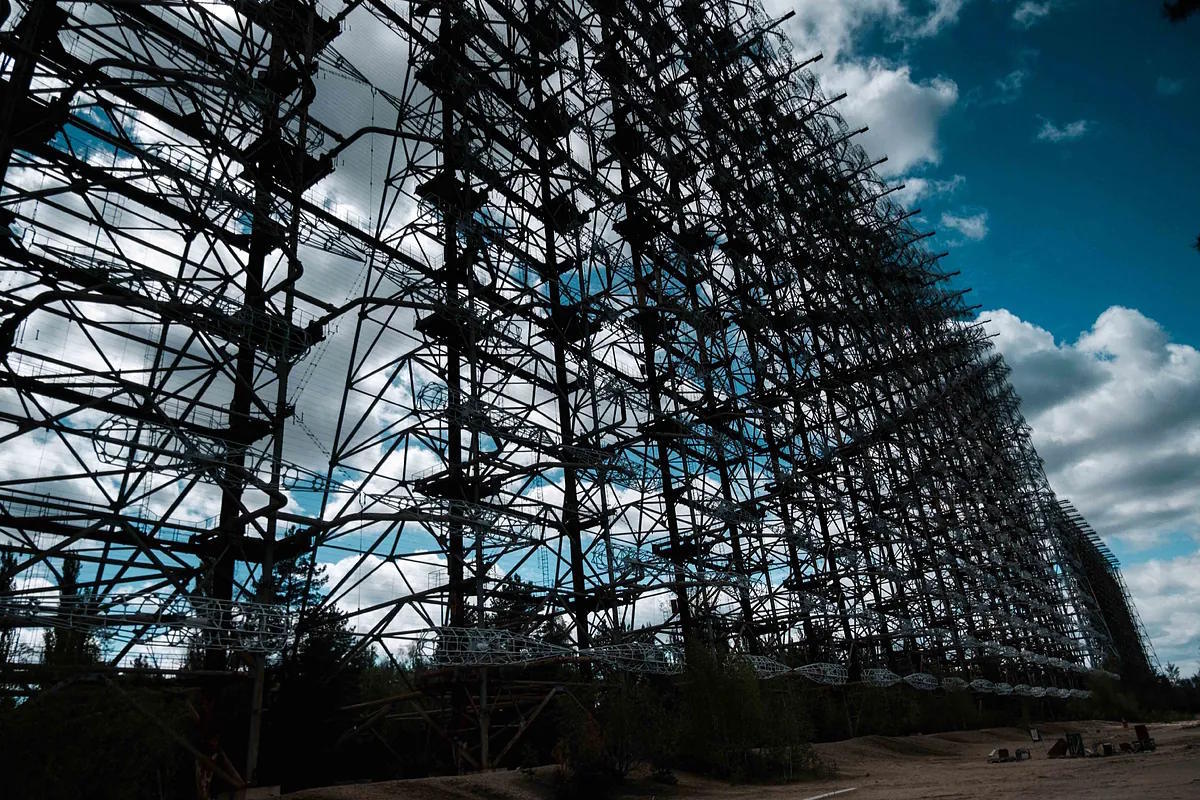At the entrance gates to the complex, rusty and already off their hinges, you can still read: "Civil Space Communication Station," its main cover, although it had nothing to do with space. After passing by the abandoned guardhouse almost 30 years ago, we suddenly come face to face with the largest antenna wall in the world, the enigmatic Duga radar, up to 150 meters high and 500 meters long, one of the most secret projects of the former Soviet Union, erected next to the Chernobyl power plant. Hidden in a forest with trees exhibiting gigantism due to radiation, this radar, stranded in the middle of the exclusion zone, is only visible from a distance, where it emerges eerily on the horizon. The wind produces haunting melodies as it passes through the metal spiderweb, whose real mission was to detect launches of American ballistic missiles in the first minutes of takeoff, bouncing waves off the ionosphere to see beyond the horizon. We immerse ourselves in its long corridor, where we access all the energy machinery and offices from which this ingenious device was controlled.
Volodimir Verbitsky, a liquidator of the nuclear plant and former resident of the abandoned city of Prypiat, shows us the bus stop that precedes the road leading to the radar. It is decorated with Misha the bear, the mascot of the 1980 Moscow Olympics. "The Soviet secret services devised these indicators as a deception. It was said that this road led to a playground, but it actually ended at the radar." Referred to as the "woodpecker" in the West, due to the repetitive sound it emitted in radio waves without the source being known, the USSR always denied its existence until it became impossible to do so, precisely following the Chernobyl accident. To this day, no one knows why it emitted such a powerful and rhythmic signal, whether it was a calibration error, a deliberate feature, or unwanted interference.
But, what does the nuclear plant have to do with this gigantic Cold War antenna complex? The Duga radar was erected next to the Chernobyl nuclear plant mainly for energy reasons. It operated through powerful high-frequency transmitters that required a constant and secure source of electricity and are now dismantled. A walk through the bowels of the complex reveals the intentional looting of machinery by the Soviet secret services, who tried to keep everything about the software, algorithms, and computing systems used unknown. All technical manuals are still missing, and the few available documents are fragmented.
"As a curiosity, I will tell you that the radar only operated at 100% of its potential for one night, and it was the night of the reactor 4 accident," Verbitsky recounts. The city where its workers lived was secret during the Soviet era. Called "Chernobyl 2," it was impossible for other Ukrainian residents of the area to visit. "I went to school with several children who lived in the city built next to the radar. They could come to Pripiat for my birthdays, but I could never go to theirs because this place was secret," Verbitsky says. Like Pripiat, the city Chernobyl 2 has disappeared, swallowed by the forest. We see the firefighters' building, the post office, the bakery oven... All frozen in time. "Even today, Ukraine is quite reluctant to show this place," comments Verbitsky. "They have not allowed journalists to enter here since the Russian invasion began. Of course, tourist access is now completely banned," Verbitsky comments. Some walls are riddled with bullet holes. Russian troops turned this into a shooting range.
The Duga was a multimillion-dollar radar technology project, but there is no solid public evidence that it performed as expected or for what it was designed. In fact, many analysts believe it never worked correctly, and that its maintenance was more political than practical. There was another twin station to Duga, known as Duga 2, in the far east of Russia, near Komsomolsk-on-Amur. It served as a second line of early detection, oriented towards the Pacific Ocean and US territory from Asia, which is also much less documented. It is believed that it never reached full operational capacity, possibly due to technical problems or atmospheric interference. It was left exposed to the elements and progressively dismantled by scrap metal dealers. In reality, what the Duga near Chernobyl preserved was the radiation from the accident, which has prevented even greater looting because it is one of the most contaminated areas. Today it remains frozen in time, with its hidden city of producers, still shrouded in mysteries.
